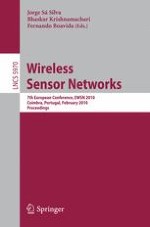It is our great pleasure to present the proceedings of the European Conference on Wireless Sensor Networks 2010 (EWSN 2010). As the field of wireless sensor networks matures, new design concepts, experim- tal and theoretical findings, and applications have continued to emerge at a rapid pace. As one of the leading international conferences in this area, EWSN has played a s- stantial role in the dissemination of innovative research ideas from researchers all over the globe. EWSN 2010 was organized by the University of Coimbra, Portugal, during February 17–19, 2010 and it was the seventh meeting in this series. Previous events were held in Berlin (Germany) in 2004, Istanbul (Turkey) in 2005, Zurich (Switz- land) in 2006, Delft (The Netherlands) in 2007, and Cork (Ireland) in 2009. A high-quality selection of papers made up EWSN 2010. Based on the reviews and the recommendations from the four live TPC discussions, we selected a total of 21 papers from 109 submissions (19.26% acceptance rate) for EWSN 2010. Topics of interest included hardware design and implementation, operating systems and so- ware, middleware and macroprogramming, communication and network protocols, information and signal processing, fundamental theoretical limits and algorithms, prototypes, field experiments, testbeds, novel applications, including urban sensing, security and fault-tolerance. Putting together EWSN 2010 was a team effort. We would like to thank the P- gram Committee members, the reviewers, our sponsors, all authors, and the Organ- ing Committee for their respective contributions.
